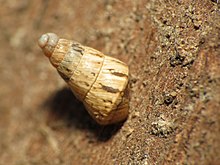| Cochlicella acuta | |
|---|---|

| |
| Scientific classification | |
| Domain: | Eukaryota |
| Kingdom: | Animalia |
| Phylum: | Mollusca |
| Class: | Gastropoda |
| Order: | Stylommatophora |
| Family: | Geomitridae |
| Genus: | Cochlicella |
| Species: | C. acuta |
| Binomial name | |
| Cochlicella acuta (O. F. Müller, 1774) | |
| Synonyms | |
| |
Cochlicella acuta, common name the pointed snail, is a species of small but very high-spired, air-breathing land snail, a pulmonate gastropod mollusk in the family Geomitridae.
Distribution
This species is native to parts of Europe. It inhabits south-western Europe including Spain, Portugal, Italy, and western Europe including France, Belgium, Netherlands and the British Isles.
In the British Isles it lives in dunes, sandhills, and grassy downs close to the sea, chiefly in the south and west of England, Wales, on islands off the west coast of Scotland, and along the Irish coast. It is extremely abundant in some areas.
The species has been introduced in the eastern Mediterranean, including Greece, Israel and Egypt.
It has also been introduced to Australia, where it has become a problematic invasive, or pest species.
Habitat


This species does well on sandy calcareous soils, and often prefers a coastal setting such as sand dunes. It aestivates by attaching itself to vertical surfaces such as fence posts, tall weeds and so on.
Shell description
The shell of this species is an unusual shape for a helicid, elongatedly conical, 10 to 20 mm high, with a width of only 4 to 7 mm. The spire tapers regularly, but ends in a blunt tip. The oval aperture has a thin lip, and the narrow umbilicus is almost covered.
The shell is very variable in color and markings, often having a cream or off-white background with many pale brown blotches, which are sometimes organized into spiral bands. The shell is often streaked across the whorls with brown. There are sometimes two spiral bands of dark brown or black, which are frequently reduced to only one band, restricted to the body-whorl. Sometimes there are no bands at all.
Welter-Schultes description. For terms see gastropod shell The 9-15 x 4-7 mm shell has 8-11 whorls, in juvenile specimens with a sharp edge. It is evenly white or with brown spots. The shell is less brownish, more slender and higher than the shell of Cochlicella barbara and upper whorls are slightly more rounded in C. acuta (juveniles have a much sharper edge at the periphery of the lowest whorl). The animal is very light yellowish, dorsum with blackish brown pigments, one dark medial line on dorsum, two dark lines (= retractor muscles) from the sides to the upper tentacles.
Ecology
Cochlicella acuta is an intermediate host for the terrestrial trematode parasite Brachylaima cribbi.
See also
References
- Müller O. F. 1774. Vermivm terrestrium et fluviatilium, seu animalium infusoriorum, helminthicorum, et testaceorum, non marinorum, succincta historia. Volumen alterum. pp. I-XXVI , 1-214, . Havniæ & Lipsiæ. (Heineck & Faber).
- MolluscaBase eds. (2020). MolluscaBase. Cochlicella acuta (O. F. Müller, 1774). Accessed through: World Register of Marine Species at: http://marinespecies.org/aphia.php?p=taxdetails&id=426379 on 2020-08-25
- "Anemoon > Flora en Fauna > Soorteninformatie". www.anemoon.org. Retrieved 25 September 2008.
- Kerney M.P. & Cameron R. A. D., 1979. A field guide to the land snails of Britain and northwestern Europe, Collins, London.
- ^ Step E. 1901. Shell life: an introduction to the British Mollusca. London, New York, F. Warne & co., page 362.
- "Item ID 2455 -- Cochlicella acuta". www.firama.com.
- Commonwealth of Australia. 2002 (April) Citrus Imports from the Arab Republic of Egypt. A Review Under Existing Import Conditions for Citrus from Israel Archived 2009-01-09 at the Wayback Machine. Agriculture, Fisheries and Forestry, Australia. Caption: Gastropods, page 12 and Appendix 2.
- "Cochlicella acuta (Müller)". www.ento.csiro.au. Retrieved 30 September 2008.
- Baker G. H, Hawke B. G. & Vogelzang B. K. 1991. Life history and population dynamics of Cochlicella acuta (Müller) (Gastropoda: Helicidae) in a pasturecereal rotation. J. Moll. Stud., 57, 259-266.
- Charwat S. M. & Davies K. A. 1999. Laboratory screening of nematodes isolated from South Australia for potential as biocontrol agents of helicid snails. Journal of Invertebrate Pathology, ISSN 0022-2011, 74(1): 55-61.
- "AnimalBase :: Cochlicella acuta species homepage". www.animalbase.uni-goettingen.de.
- Butcher A. R. & Grove D. I. 2006. Seasonal variation in rates of sporocyst and metacercarial infection by Brachylaima cribbi in helicid and hygromiid land snails on the Yorke Peninsula, South Australia. - Australian Journal of Zoology, 53(6): 375–382.
- Pulteney, R. (1799). Catalogue of the birds, shells, and some of the more rare plants of Dorsetshire. London, Nichols, 92 pp.
- Provoost, S.; Bonte, D. (Ed.) (2004). Animated dunes: a view of biodiversity at the Flemish coast . Mededelingen van het Instituut voor Natuurbehoud, 22. Instituut voor Natuurbehoud: Brussel, Belgium. ISBN 90-403-0205-7. 416, ill., appendices pp.
- Kerney, M.P., Cameron, R.A.D. & Jungbluth, J-H. (1983). Die Landschnecken Nord- und Mitteleuropas. Ein Bestimmungsbuch für Biologen und Naturfreunde, 384 pp., 24 plates.
External links
- Cochlicella acuta at Animalbase taxonomy,short description, distribution, biology,status (threats), images
- Cochlicella acuta images at Encyclopedia of Life
- Fauna Europaea Search Distribution
- Müller, O. F. (1774). Vermium terrestrium et fluviatilium, seu animalium infusorium, Helminthicorum, et testaceorum, non marinorum, succincta historia. vol 2: I-XXXVI, 1-214, 10 unnumbered pages. Havniae et Lipsiae, apud Heineck et Faber, ex officina Molleriana
- Risso A. (1826). Histoire naturelle des principales productions de l'Europe méridionale et particulièrement de celles des environs de Nice et des Alpes Maritimes, vol. 4. Paris: Levrault. vii + 439 pp., pls 1-12